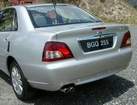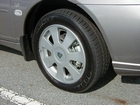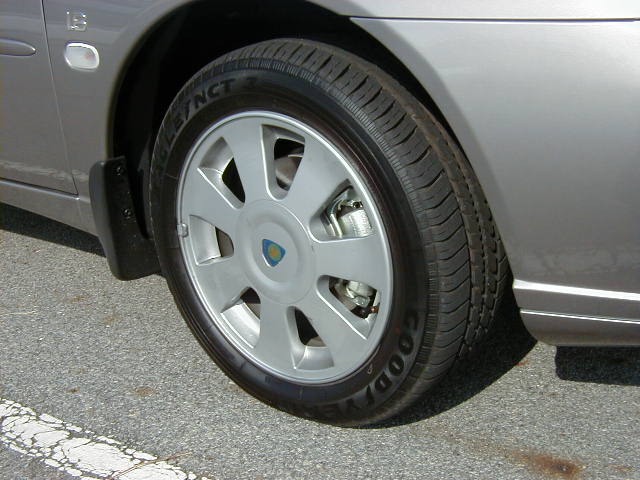First Driving Impressions: Proton Waja 1.8X
PRICES:
Waja 1.8X (Type A -without Captor Security System) RM77,249.82
Waja 1.8X (Type B – with Captor Security System) RM78,674.82
At long last, the Proton Waja 1.8 has arrived. It has never been a secret since it was mentioned as part of the long-term line-up for Proton’s first self-developed model when the Waja was launched in August 2000. Various introduction dates were mentioned over the past 28 months and as they came and went, people wondered if the variant would ever appear.
It was believed that ‘interfacing’ problems were causing delays: unlike the Mitsubishi-based engine used for the Waja 1.6, the Waja 1.8 would use an engine supplied by Renault. This probably meant that the engineers had to spend a bit more time to properly mate the powertrain to the Waja platform as the mounting points would be different. However, a source said that it wasn’t interfacing problems that had resulted in the Waja 1.8 taking so long to be launched but declined to elaborate on the reasons.
Anyway, as outlined in our article when the Waja was launched two years ago, the 1.8-litre engine comes from the widely-used Renault F4 family and the powertrain being supplied to Proton is similar to that used in the latest Renault Laguna II. It isn’t the first European engine used by Proton (the Tiara had a Citroen engine, remember?) but it is the first European engine bought by Proton for its own model.
The F4P engine is a 4-cylinder DOHC unit with four valves per cylinder and its 1783 cc is derived from a configuration of 82.7 mm bore and 83 mm stroke. In Euro 2 emission control form, its output is 88 kW of maximum power at 5750 rpm and maximum torque of 169 Nm available at between 2000 and 4500 rpm. These figures are slightly different from those in the engine used in the Laguna II, partly because the Laguna’s engine is tuned for the tougher Euro 3 standards required in Europe and also because of Proton’s requirements for the Waja’s driving character.
At the time of writing, the weight of the Waja 1.8 was not supplied but it should be more than the 1205 kgs of the Waja 1.6 automatic. Nevertheless, with a power increase of 15.8% and torque being 21% greater, the weight-to-power ratio should be better.
The engine also features, for the first time in a Proton, variable valve timing (VVT). A trend in newer engines, VVT overcomes the problem of tuning an engine for optimum performance at both ends of the motoring spectrum. A mechanism which works on the inlet valves alters their opening and closing duration according to driving conditions, filling the cylinders with the right amount of air and fuel.
The VVT mechanism in the Waja’s engine (which Aisin Seiki, a Toyota Group company, supplies to Renault) works in two distinct stages and the change is executed in 500 milliseconds. When the accelerator pedal is floored beyond 90% travel – typically when the driver wants to accelerate strongly – the valve timing is changed by 16 degrees to suit high-speed demands. This means that strong torque is available at low speed around town and also at high cruising speeds; something that was previously not possible with a single camshaft profile.
Other features of the engine include roller cam followers that have less valvetrain friction, static ignition with pencil coils and two lightweight hollow camshafts. A compact air filter also sits on top of the engine, hidden from sight by a smart looking engine cover.
The powertrain also has ‘drive-by-wire’ features, specifically for the throttle control. In place of the mechanical method of adjusting the throttle position as engine demands continuously change, electronic controls make the change. This means quicker response and in the longer term, greater reliability as less mechanical parts are present.
For the time being, the Waja 1.8 is available only with an automatic transmission. This too is supplied by Renault and is thus well matched to the engine. The 4-speed unit is said to be one of the new-generation types with an auto-adaptive feature. Its fuzzy logic gives it the ability to continuously change its character according to driving conditions as well as driving style, choosing from nine pre-programmed shift ‘maps’.
With the auto-adaptive feature, it is claimed that the feel can be sporty without having to provide the ‘sport’ and ‘economy’ modes which are found in some cars. Each driver will find the shifting character gradually adapting to his or her way of driving after a short distance (15 to 20 kms).
Those used to conventional automatic transmissions shifting to the highest gear the moment the foot is lifted off the accelerator pedal will discover that the transmission in the Waja 1.8 behaves differently in certain conditions. It will shift down by itself during hard braking or prolonged braking and certain other situations which the on-board computer will recognize. This is to provide additional engine braking, useful in many instances and is quite typical of programming in French cars.
In other respects, the Waja 1.8 has received engineering changes which would be necessary to cope with the increased performance capability. Again, Lotus Engineering was called upon to work on the suspension and in retuning the suspension, a switch was made from the Kayaba gas dampers used for the Waja 1.6 to units supplied by APM. Also changed is the wheel size which is now 16 inches (9-spoke instead of 7 spokes) and fitted with Goodyear NCT5 205/50 tyres, chosen for their reputation for quietness and performance.
Lotus engineers also worked on the Ride and Handling which have been widely praised. New bushes have been used and additional measures have been taken to reduce noise, vibration and harshness (NVH) to provide a ‘continental car experience’.
In terms of safety features, the Waja 1.8 has similar equipment as the equivalent versions in the Waja 1.6. The Waja 1.8X has dual front airbags and larger front discs as well as standard ABS with Brake Assist (BA) and Electronic Brake Force Distribution (EBD).
BA is something which brake manufacturers have begun including in systems and this has been easily done because of the sensors and other electronic gear already installed for the ABS. BA was introduced following studies that showed many drivers do not make full use of braking power in an emergency, something which is necessary for ABS to work well. With BA present, braking power can be automatically boosted during emergency braking, the situation being determined by the computer which analyses speed of depressing the pedal and vehicle speed.
EBD is also common in many brake systems today and is a more advanced approach from the old load-sensing valve mechanism. It uses electronics to optimize brake force and balance between the front and rear brakes according to the load on board. This significantly reduces the incidence of skidding when the load is light and the road is slippery.
In other respects, you can’t tell a Waja 1.8 from a Waja 1.6. Exterior features are identical … no re-profiled bumpers or different grille or lighting units. But from behind, there is one give-away – the Waja 1.8 has twin tailpipes on the left side. And like most Proton models, the model badge is provided for just one side of the car…
Interior equipment also follows that of the Waja 1.6, with leather and wood trim for the Waja 1.8X and a high-quality Clarion audio system with integrated single CD player.
continued on page 2, link below




































